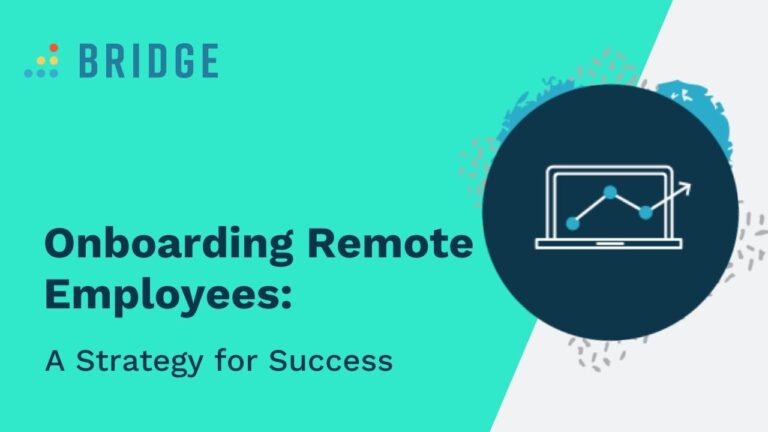First impressions matter. Your organization’s onboarding process has the power to make or break how engaged your employees are and whether they have the skills needed to grow.
According to Gallup, onboarding can influence employee experience more than any other factor. When organizations deliver amazing onboarding, employees are 40% more likely to believe the job is as good as or better than expected, and 30% more likely to feel prepared to excel.
How to Create an Employee Onboarding Strategy
An effective onboarding process integrates employees into your company and gives them the knowledge, support, and tools they need to perform at their best. A structured onboarding process is a must—especially for remote and hybrid workers. By supporting new hires to build relationships and complete training and development opportunities, you’re investing in their future success.
Great onboarding benefits your entire workforce—when new employees reach their potential more quickly, they’ll be on the same page as the rest of your team and driving business outcomes sooner.
Cisco’s 2022 report looked at some of the top success factors for hybrid and remote employees:
- Access to technology and technological support (78%)
- Supportive management (70%)
- Good company and team culture (56%)
Creating a supportive and welcoming environment for employees to grow and perform at their best matters right from the beginning. Here’s how to deliver impactful experiences:
CREATE IMPACTFUL ONBOARDING EXPERIENCES | ‘Employee Onboarding Template’
1) Connect With New Hires During Preboarding
The preboarding stage is a great time to answer questions and send over any necessary documentation new employees need to complete ahead of their first day. It’s also an opportunity to learn more about them—it’s never too early to create a meaningful experience, and the sooner managers connect with employees, the better. Microsoft research reveals that when managers play an active role in the onboarding process, employees are nearly four times more likely to be satisfied with their experience and are more likely to contribute to their team’s success.
An effective way to get to know new team members is with Bridge Drivers. The card-based game reveals what matters most to employees, what they want to achieve, and what kind of culture makes them feel most engaged and productive. Not only does it allow employees to define what they want to accomplish in their careers, it’s a great way of showing that your organization values their development.
Managers should also send an email to welcome their new hire on board, including a video from leadership and team members talking about why they love the company. It’s helpful for new hires to put a face to a name and get a feel for your company culture before they start. Videos don’t need to be created every time. They can be reused based on department or role, but be sure to update it often so the information is never outdated!
2) Personalize Onboarding to Each Individual
Onboarding is a busy time for employees. Between getting to grips with new processes, learning who does what, and where to find the information they need, there’s lots to remember! This is especially true for remote and hybrid workers, because it’s not always as obvious who to ask when they need a hand. Personalized onboarding templates detailing exactly what new hires need to know will make them feel more confident and speed up the learning process.
Outline what they need to know at every stage, including their tasks, systems and logins, and details of who does what. If they have mandatory training to complete, schedule reminders to keep them on target. Templates don’t need to be made from scratch—repurpose some elements depending on job title, location, seniority, location, or department.
RELATED READING | ‘How Personalized Learning Enhances Employee Skills Development’
3) Automate the Onboarding Process
Supporting multiple new hires alongside other direct reports means that even the most organized managers can sometimes lose sight of where everything’s up to. Take advantage of notifications and reminders for a simple way to keep employees and managers on track with one-on-ones.
Scheduling checkpoints and reminders throughout the onboarding journey streamlines processes for managers and new hires. Controlling the onboarding journey creates a personalized experience, as employees can access tasks and training at relevant points. This means managers can schedule one-on-ones and catch-ups at crucial milestones to check on progress and offer more relevant and actionable feedback.
FIND OUT HOW BRIDGE HELPED ONE COMPANY CUT ONBOARDING TIME BY 67% | ‘TransAmerican’s Success Story’
4) Define Future Goals Early On
It’s never too early to talk about career development, and for new hires to make an impact, they need goals. Managers should schedule career conversations in the first few weeks to uncover what employees want to achieve, where they want to go in their roles, and what skills they need to get there. Once they’ve identified their career vision, they can work together to set individual performance goals.
Successful onboarding should also make employees aware of their role in achieving team and organizational success. Goal setting should always happen on individual, team, and organizational levels and tie back to wider objectives. Aligning performance metrics gives employees a better understanding of their own goals and adds purpose to the work that they’re doing.
DISCOVER HOW TO NURTURE YOUR EMPLOYEES’ TALENTS | ‘The Definitive Guide to Employee Development’
5) Make Training Engaging
Training must always be relevant and engaging, whether an employee is completing a mandatory compliance course, familiarizing themselves with a product, or developing a new skill. Mix up formats and be mindful of course length to keep employees focused—quizzes, infographics, and videos are ideal ways to deliver short bursts of information. Always break learning down and assign it in small pieces rather than all at once. This way, your people won’t be overwhelmed by the volume and can easily make time in their day.
Look for peer learning opportunities too, as employees are more likely to retain information if it’s relevant to them and how they do things. Employee-generated videos, live Q&A sessions, or job shadowing opportunities all give new starters hands-on experience with their new role.
DELIVER MEMORABLE WORKPLACE TRAINING | ‘10 Facts & Stats About Learning Retention You’ll Want to Remember’
6) Promote Regular Communication
New hires should have time to meet with their manager, teammates, and key stakeholders in the first weeks. Make sure this includes someone involved during the interview, so they see a familiar face too. These meetings give their role context and the chance to learn from others in the first weeks.
It’s not enough to encourage these conversations during the onboarding process. New employees need to see that their organization creates space for meaningful conversations. Team catch-ups and one-on-ones are especially important in the early days when new hires are getting up to speed with their role and responsibilities, but they shouldn’t be abandoned once the onboarding stage is over. In addition to regular meetings, managers should always communicate an open-door policy and employees should always be given the freedom to decide their development goals and share knowledge.
A performance management platform can facilitate connections throughout the company and allow employees to connect. By listing job title, skills, interests, and background, they can easily find coworkers to learn from and build connections based on shared knowledge and career goals.
YOU MIGHT ALSO LIKE | ‘How Connecting With Employees Helps Strengthen Organizational Resilience’
7) Define Your Company Culture
Think of company culture as the personality of your organization. More than just a list of values and statements, it’s a set of traits that aligns your people, connects them through a shared purpose, and influences how satisfied they are with their work. A strong company culture that your people invest in is also the most critical driver of business performance, overtaking strategy or operations, according to PwC’s 2021 organizational culture report.
Your culture is communicated in everything your organization does. It’s helpful to define your culture and create a set of values as a starting point, as this illustrates your beliefs and how you do things day-to-day. But company handbooks and policy documents alone aren’t enough for new hires to really understand and embrace your culture. To integrate new employees seamlessly, you must show them what it means.
Show your culture in action and connect your organization at all levels. Assigning an onboarding buddy who’s informed about the company’s direction and has developed within their role can offer unique insight and get them up to speed quickly by guiding them through the first few weeks. Since your leaders are at the forefront of shaping culture, they should play an active role in showing your culture regularly. A well-stocked video library of on-demand content recorded by thought leaders and SMEs to guide new starters through mandatory training and company policies can help them feel more connected to their organization and see how these behaviors are practiced.
8) Ask for Feedback
Creating an onboarding journey that resonates with everyone takes time, feedback, and evaluation. Even the most carefully planned process might need to be refined. One of the best ways to discover what’s working (and what isn’t) is to ask. Use surveys to gather feedback and see how your recently-onboarded employees found the experience and what could be improved. Asking these questions about experience shows that you care and you’re committed to making change.
Be sure to send out regular employee engagement surveys, as they’re a useful way to spot trends and analyze data. They won’t provide an immediate understanding of how to support individuals, but results can be used to revamp the process for future hires.
Create Great Onboarding Experiences With Bridge
Bridge gives you the tools to create memorable employee experiences right from day one. Empower your people to realize and achieve their full potential with engaging and personalized training. Control every element to create, deliver, and automate personalized training that sets your employees up for success.
With the integration of performance management elements, it’s easy to connect employees with coworkers and managers through one-on-ones and feedback, and measure the impact of learning and development.




